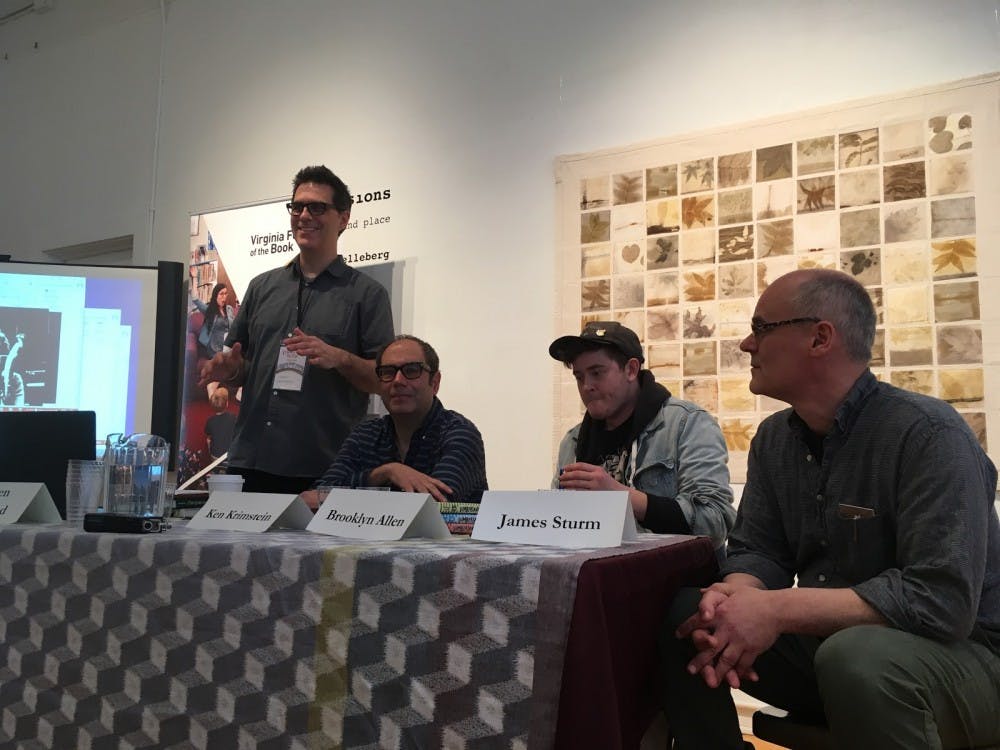Most of the panels at the Virginia Festival of the Book — which took place March 20-24 in various venues around Charlottesville — surround the idea of a traditional print novel. However, graphic novels are slowly entering the mainstream, and “The Power of Graphic Novels” was an event that showed that graphic novels are the perfect gateway to attaining what artist James Sturm called “visual literacy.”
The panel, which convened Saturday at the McGuffey Art Center, consisted of three artists whose novels catered to varied audiences. Three accomplished cartoonists — James Sturm, author of “Off Season,” Ken Krimstein (“The 3 Escapes of Hannah Arendt”) and Brooklyn Allen, illustrator of the “Lumberjanes” series — sat with Warren Craghead, a local artist, to discuss their views on the power of graphic novels.
Each artist noted that the idea of using pictures to comprehend and translate the world around them motivated them to pursue cartooning. Both Krimstein and Sturm cited “Peanuts” by Charles Schulz as being a huge inspiration for them, as it took an abstract drawing and gave it a story and a life. According to Krimstein, pictures are a great tool for narration. In an age where we often learn through what we see, this is a perfect way to translate an intricate topic simply.
In the book “The 3 Escapes of Hannah Arendt,” Krimstein uses single panels to explain large portions of Hannah Arendt’s philosophy and manages to make it digestible for the non-philosophical average reader. Allen also echoed this sentiment by talking about how he manages to pack entire scenes into a singular panel so as to keep the action flowing and the “frantic energy” intact.
Arts and Entertainment had the opportunity to sit with Krimstein and Sturm to talk about their specific views on the world of cartoons and graphic novels. Both of them have written books regarding very dark topics, specifically dealing with politics — and in Krimstein’s case, the Holocaust.
“I was going through a hard time in my life, and I make comics just to process the world,” Sturm said. “Being able to break it down and put it in neat little orderly boxes on a page is very reassuring and gives me a sense of agency and control we often don’t have in life.”
The format of a graphic novel allows so much more to be said in so much less. A single panel can provide context through narration as well as emotion through the artwork. The idea of mixing narration and points of view can create a new angle many traditional novels lack.
“The way that you can play with the narrative point of view creates a tension that brings the viewer, the reader, into it,” Krimstein said.
“You are kind of mixing what you are showing and what you are telling and somehow hoping that the sum becomes greater than the parts,” Sturm added.
Graphic novels can also take a story past the limits of what a print novel could possibly do.
“[In my book] the characters all have dog heads, and I don’t really bring attention to it, and I can’t imagine how I would do that in prose,” Sturm said.
All three cartoonists use methods of abstraction and elements of the fantastical to add depth to the story in a way that prose would make too structured. The element of translated reality allows the reader to place herself into the story and “a higher level of meaning,” according to Krimstein.
The panel also dealt both with the economic and the technical aspects behind illustrating. All three panelists agreed — do not go into cartooning for the money. They all stated how they got involved for the passion of it, not for glory and fame. Krimstein added how he loved drawing, but the idea of also occasionally getting money for his work is also great.
The three also agreed that each graphic novel should be treated as its own separate project and that graphic novels cannot be generalized. Whether it be the topic, the method of creation or the publishing process, the graphic novel is an utterly personal passion project.
In this day and age, where most humor is translated into images via memes, the idea of a graphic novel seems to be the perfect entryway into modern communication. The combination of words, pictures and points of view is simple for both children and adults to understand, and by creating a print version of this variant of modern culture, it can diversify and spread this idea to a much larger portion of the world.







